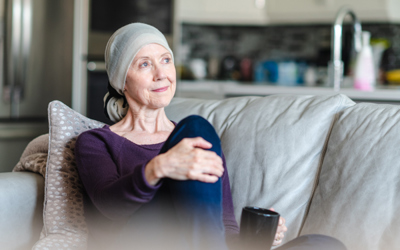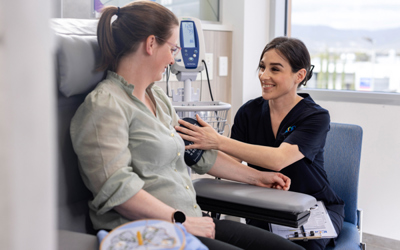What are the treatment options for testicular cancer?
The treatment options for testicular cancer may include surgery, surveillance, chemotherapy and radiotherapy. The type of treatment you receive will depend on several different considerations, such as the type of testicular cancer you have, its stage, your overall health and your treatment preferences. This page aims to give you a comprehensive overview of how testicular cancer treatment works.
Active surveillance for testicular cancer
In some cases, people with testicular cancer may not need any further treatment after an orchidectomy. This is called surveillance, which involves regular monitoring using CT scans and blood tests for up to 10 years. If your care team finds signs of cancer, you will start active treatment again. Your surveillance schedule will depend on the type of testicular cancer you have.
Surgery for testicular cancer
Surgery is performed to remove cancerous tissue and reduce the risk of testicular cancer spreading from the testicle to surrounding areas of the body. It is the most common treatment for testicular cancer and the primary treatment for cancer that has not spread.
Common types of surgery include:
-
Orchidectomy
An orchidectomy is the main surgical procedure for testicular cancer that has not spread. In an orchidectomy, the tumour and entire testicle is removed, along with the spermatic cord. A small incision is made in the groin above the pubic cord and the testicle is removed from the scrotum. During this surgery, you may choose to have a prosthetic testicle inserted within the scrotum to maintain the appearance of your testicle.
-
Retroperitoneal lymph node dissection
In some instances, your surgeon may recommend the removal of the retroperitoneal lymph nodes at the back of the abdomen. Retroperitoneal lymph node dissection (RPLND) is a complex procedure that is commonly performed as an open surgery, although keyhole surgery may be used.
Open RPLND – Where a long incision is made through the abdominal wall to remove the lymph nodes
Keyhole (laparoscopic) RPLND – A minimally invasive procedure that uses very small incisions to access the lymph nodes within the abdomen. Keyhole procedures result in less postoperative pain and complications, a shorter hospital stay and faster recovery compared to open RLND, however the effectiveness of this approach is still being determined.
The type of surgery you receive will also have an impact on your fertility. In an orchidectomy, it is rare to have both testicles removed. This means that you may still be able to have children naturally. A retroperitoneal lymph node dissection can also damage the nerves that impact ejaculation and potentially result in a condition called retrograde ejaculation, which can lead to infertility. Your care team can help you manage any fertility changes during your treatment.
Radiotherapy for testicular cancer
Radiotherapy is often used to treat seminoma, a type of testicular cancer. This is because seminoma cells are highly sensitive to radiation. The radiation is typically targeted at your lymph nodes after surgery to destroy any cancer that may have been left behind and prevent it from coming back. Radiotherapy can also treat testicular cancer that has spread beyond the testicle to other parts of the body.
Types of radiotherapy commonly used for people with testicular cancer include:
External beam radiotherapy
External beam radiotherapy (EBRT) is used to treat testicular cancer by delivering highly targeted radiotherapy beams.
Radiotherapy can impact your fertility by reducing your sperm count and damaging the sperm’s health. If you have any concerns about fertility, your care team can help.
Chemotherapy for testicular cancer
Chemotherapy uses a range of drugs to kill and slow the growth of testicular cancer cells. It is typically used to cure testicular cancer that has spread beyond the testicle. This is because cancer in the testicle can often be treated with surgery alone. However, it may be used if your care team determine that you have a moderate risk of the cancer spreading or coming back. Your care team will walk you through how many cycles you will need for your course of treatment.
Learn more about chemotherapy and how it is delivered.
Chemotherapy can impact your fertility by reducing your sperm count and damaging the sperm’s health. If you have any concerns about fertility, your care team can help.
Common chemotherapy medicines
There are a number of different chemotherapy drugs that are used to treat testicular cancer. These drugs are typically combined based on factors such as the type of cancer, your cancer’s size and how much it has spread. Some of the drugs used include:
-
Cisplatin
This is a platinum compound that works by binding to and damaging DNA within cancer cells, preventing them from being able to divide and grow. It may be used as an adjuvant therapy after surgery to destroy any remaining cancer cells and help prevent the cancer from returning. It is also used to treat advanced (metastatic) and recurrent testicular cancer. Cisplatin is given by intravenous infusion, usually in combination with other chemotherapy drugs, with each infusion typically given over 60 minutes.
-
Bleomycin
This works by interfering with the process of cell division, destroying rapidly dividing cells such as cancer cells. It may be used as an adjuvant therapy after surgery to destroy any remaining cancer cells and help prevent the cancer from returning, and for the treatment of advanced (metastatic) testicular cancer in combination with other chemotherapy drugs. Bleomycin may be given by intramuscular injection or intravenous infusion.
-
Ifosfamide
Ifosfamide is an alkylating chemotherapy drug that works by damaging the DNA of cells so that they are unable to divide and grow. It may be used as an adjuvant therapy after surgery to destroy any remaining cancer cells and help prevent the cancer from returning. In combination with other chemotherapy drugs, Ifosfamide may be used to treat advanced (metastatic) and recurrent testicular cancer.
-
Etoposide
This chemotherapy drug works by blocking an enzyme called topoisomerase, which cancer cells need to reproduce and grow. It may be used as an adjuvant therapy after surgery to destroy any remaining cancer cells and help prevent the cancer from returning and for the treatment of advanced (metastatic) testicular cancer in combination with other chemotherapy drugs. It is given by intravenous infusion, with each infusion given over 30 to 60 minutes.
-
Paclitaxel
This chemotherapy drug works by disrupting cell division and other normal cell activity, causing the cancer cells to die. It is given by intravenous infusion every three weeks in combination with other chemotherapy drugs to treat recurrent testicular cancer.
Some common combinations (known as chemotherapy protocols) include:
EP – etoposide and cisplatin
BEP – bleomycin, etoposide and cisplatin
VIP – etoposide, ifosfamide, cisplatin
TIP – paclitaxel, ifosfamide, cisplatin
Clinical trials for testicular cancer
Icon offers clinical trials across a wide range of cancer types and treatments. If you would like more information on participating in a clinical trial, please speak with your doctor who will be able to find a trial that might be right for you and your cancer.

Treatment by stage of testicular cancer
When you are diagnosed with testicular cancer, your oncologist will develop your treatment plan as part of a multidisciplinary team based on the stage of your cancer. This will depend on the type of testicular cancer you have: seminoma or non-seminoma.
Common treatment options for each stage of testicular cancer include:
Stage I testicular cancer
Seminoma: For many people with stage I seminoma, an orchidectomy will be the only treatment required. This is often followed by a surveillance schedule for up to 10 years. In some cases, you may also receive radiotherapy directed to the lymph nodes in the back of the abdomen or chemotherapy.
Non-seminoma: Like seminoma, an orchidectomy can potentially cure stage I non-seminoma. You may also receive a retroperitoneal lymph node dissection to reduce the risk of your cancer coming back. Depending on your type of cancer, this can be combined or switched with chemotherapy after surgery.
Stage II testicular cancer
Seminoma: After an orchidectomy, you may have chemotherapy or radiotherapy. This depends on your treatment recommendation and your personal preferences.
Non-seminoma: For stage II non-seminoma, you will receive an orchidectomy which may be followed by a retroperitoneal lymph node dissection to your lymph nodes in the back of the abdomen. Chemotherapy is also a common treatment option with a long-term follow up.
Stage III testicular cancer
Seminoma and non-seminoma: After surgery, chemotherapy is a common treatment for stage III seminoma and non-seminoma. Chemotherapy can otherwise be provided before surgery depending on how far the seminoma has spread. Radiotherapy may also be given depending on your cancer.









